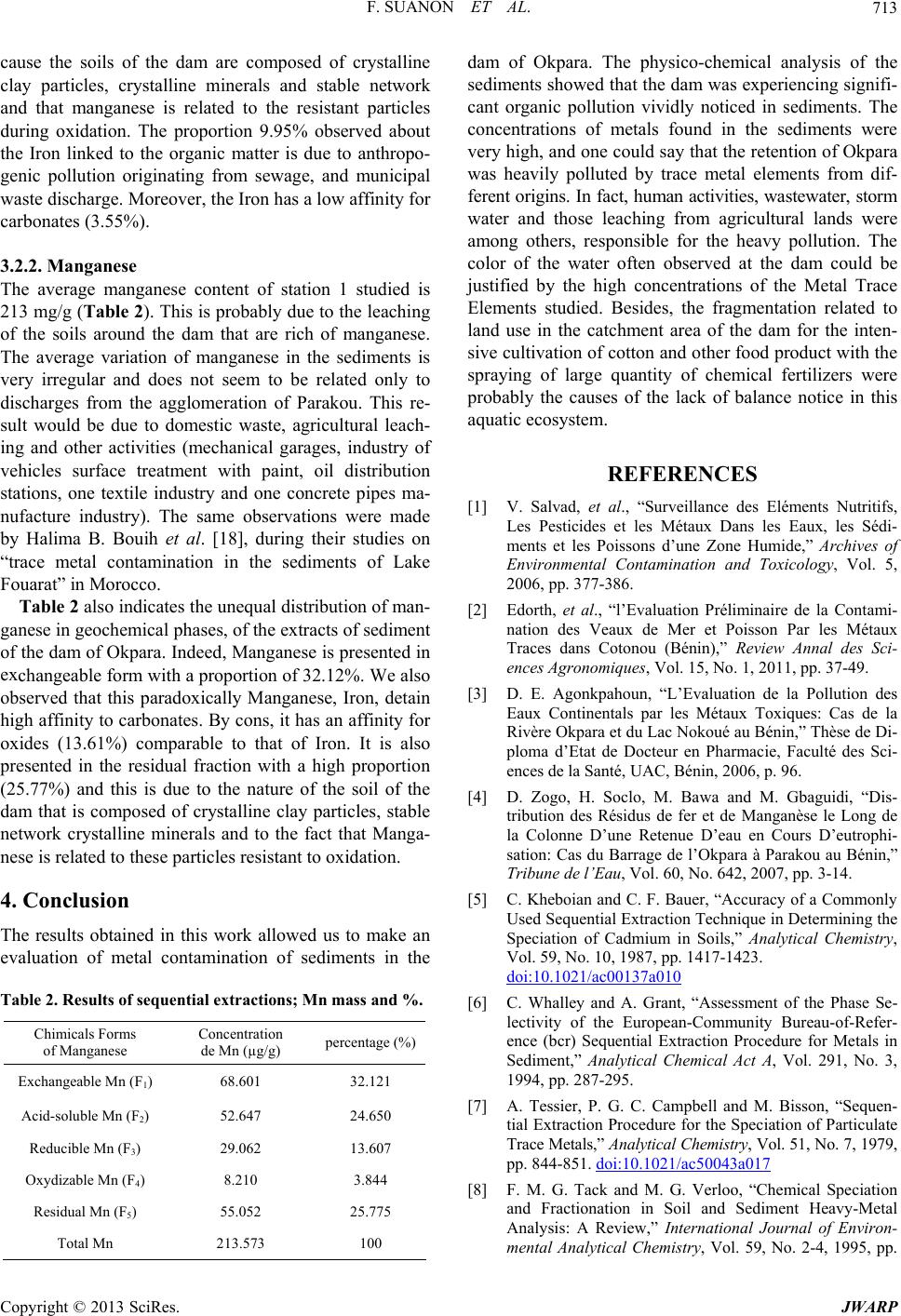
F. SUANON ET AL. 713
damhe physiical analysis of the
sediments showed that the daxperiencing
cant orlution vividld in sedim
[1] V. Salvad, et al., “Surveillance des Eléments Nutritifs,
Les Pesticideses Eaux, les Sédi-
ments et les Pmide,” Archives of
u (Bénin),” Review Annal des Sci-
i-
D’eutrophi-
istry,
cauthe dam posed of crystalline
clay pae mind stable nwork
and thanese is relaresistanticles
ese content of station 1 studied is
213 mg/g (Tab le 2). This is probably due to the leaching
the dam that are rich of manganese.
Indeed, Manganese is presented in
ex
an
al contamination of sediments i
percentage (%)
se the soils of are com
rticles, crystallin
t manga
erals an
ted to the
et
part
during oxidation. The proportion 9.95% observed about
the Iron linked to the organic matter is due to anthropo-
genic pollution originating from sewage, and municipal
waste discharge. Moreover, the Iron has a low affinity for
carbonates (3.55%).
3.2.2. Mangan es e
The average mangan
of the soils around
The average variation of manganese in the sediments is
very irregular and does not seem to be related only to
discharges from the agglomeration of Parakou. This re-
sult would be due to domestic waste, agricultural leach-
ing and other activities (mechanical garages, industry of
vehicles surface treatment with paint, oil distribution
stations, one textile industry and one concrete pipes ma-
nufacture industry). The same observations were made
by Halima B. Bouih et al. [18], during their studies on
“trace metal contamination in the sediments of Lake
Fouarat” in Morocco.
Table 2 also indicates the unequal distribution of man-
ganese in geochemical phases, of the extracts of sediment
of the dam of Okpara.
changeable form with a proportion of 32.12%. We also
observed that this paradoxically Manganese, Iron, detain
high affinity to carbonates. By cons, it has an affinity for
oxides (13.61%) comparable to that of Iron. It is also
presented in the residual fraction with a high proportion
(25.77%) and this is due to the nature of the soil of the
dam that is composed of crystalline clay particles, stable
network crystalline minerals and to the fact that Manga-
nese is related to these particles resistant to oxidation.
4. Conclusion
The results obtained in this work allowed us to make
evaluation of met
n the
Table 2. Results of sequential extractions; Mn mass and %.
Chimicals Forms Concentration
of Manganese de Mn (µg/g)
Exchangeable Mn (F) 68.601 32.121
1
Ac 2)
2
id-soluble Mn (F52.647 24.650
Reducible Mn (F3) 29.062 13.607
Oxydizable Mn (F4) 8.210 3.844
Residual Mn (F5) 55.052 25.775
Total Mn 13.573 100
of Okpara. Tco-chem
m was e
y notice
signifi-
ents. Theganic pol
concentrations of metals found in the sediments were
very high, and one could say that the retention of Okpara
was heavily polluted by trace metal elements from dif-
ferent origins. In fact, human activities, wastewater, storm
water and those leaching from agricultural lands were
among others, responsible for the heavy pollution. The
color of the water often observed at the dam could be
justified by the high concentrations of the Metal Trace
Elements studied. Besides, the fragmentation related to
land use in the catchment area of the dam for the inten-
sive cultivation of cotton and other food product with the
spraying of large quantity of chemical fertilizers were
probably the causes of the lack of balance notice in this
aquatic ecosystem.
REFERENCES
et les Métaux Dans l
oissons d’une Zone Hu
Environmental Contamination and Toxicology, Vol. 5,
2006, pp. 377-386.
[2] Edorth, et al., “l’Evaluation Préliminaire de la Contami-
nation des Veaux de Mer et Poisson Par les Métaux
Traces dans Cotono
ences Agronomiques, Vol. 15, No. 1, 2011, pp. 37-49.
[3] D. E. Agonkpahoun, “L’Evaluation de la Pollution des
Eaux Continentals par les Métaux Toxiques: Cas de la
Rivère Okpara et du Lac Nokoué au Bénin,” Thèse de D
ploma d’Etat de Docteur en Pharmacie, Faculté des Sci-
ences de la Santé, UAC, Bénin, 2006, p. 96.
[4] D. Zogo, H. Soclo, M. Bawa and M. Gbaguidi, “Dis-
tribution des Résidus de fer et de Manganèse le Long de
la Colonne D’une Retenue D’eau en Cours
sation: Cas du Barrage de l’Okpara à Parakou au Bénin,”
Tribune de l’Eau, Vol. 60, No. 642, 2007, pp. 3-14.
[5] C. Kheboian and C. F. Bauer, “Accuracy of a Commonly
Used Sequential Extraction Technique in Determining the
Speciation of Cadmium in Soils,” Analytical Chem
Vol. 59, No. 10, 1987, pp. 1417-1423.
doi:10.1021/ac00137a010
[6] C. Whalley and A. Grant, “Assessment of the Phase Se-
lectivity of the European-Community
ence (bcr) Sequential Extract
Bureau-of-Refer-
ion Procedure for Metals in
tical Chemistry, Vol. 51, No. 7, 1979,
Sediment,” Analytical Chemical Act A, Vol. 291, No. 3,
1994, pp. 287-295.
[7] A. Tessier, P. G. C. Campbell and M. Bisson, “Sequen-
tial Extraction Procedure for the Speciation of Particulate
Trace Metals,” Analy
pp. 844-851. doi:10.1021/ac50043a017
[8] F. M. G. Tack and M. G. Verloo, “Chemical Speciation
and Fractionation in Soil and Sediment Heavy-Metal
Analysis: A Review,” International Journal of Environ-
mental Analytical Chemistry, Vol. 59, No. 2-4, 1995, pp.
Copyright © 2013 SciRes. JWARP